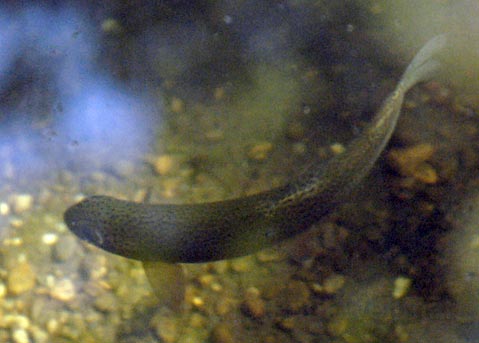Bye-Bye to Backcountry Fishing?
To Save the Steelhead, Environmentalists Work to Shut Down Anglers on Sespe and Sisquoc Creeks

Fishing in remote parts of the Santa Barbara backcountry may one day be a thing of the past, as environmentalists are working to ban all forms of angling — including catch and release — on the Sepse and Sisquoc creeks in order to help save the endangered steelhead trout. The fish’s existence may also be threatened by the five-fish bag limit on the north fork of Matilija Creek, say environmentalists, so they are also seeking to make that stretch strictly catch and release.
The emergency closure request, which was issued by the Santa Barbara-based Environmental Defense Center, was heard on Wednesday morning, November 16, by the California Fish and Game Commission, which is meeting at the Veteran’s Memorial Hall on Cabrillo Boulevard this week. Following the guidance of Department of Fish and Game staff — which supports closing the Sisquoc, but wants to study the Sespe more and does not see the need for changes to the Matilija — the commission decided against any immediate action, instead planning to wrap any changes into the statewide regulation update that happens every three years. The next round of that process starts in June 2012, so the discussion, which pits the closure advocates against many fishermen, will continue next summer.
If Wednesday’s meeting was any indication, it’s likely to be a lively debate, as are most conservation-minded attempts to limit recreational opportunities on public lands. Although both the Environmental Defense Center (EDC) and various fishing representatives spoke positively of the cooperation and conversations that have already occurred on the matter, the two camps will likely remain divided on banning fishing on the Sespe and Sisquoc — where only catch and release is currently allowed — and there may also be some less-vehement disagreement over Matilija as well. The argument presented by Brian Trautwein of the EDC is that the closure is merely an attempt to amend a 14-year-old “oversight” that’s allowed state fishing laws to conflict with the federal Endangered Species Act.
The oversight isn’t hard to understand, as the law protecting the steelhead is a little convoluted: Steelhead and the more commonly known rainbow trout — which live in the inland creeks and lakes — are genetically the same species, but if a rainbow makes it to sea, then it becomes a steelhead. So when the federal Endangered Species Act was applied to the steelhead in 1997, it also protected all rainbow trout that may one day have a chance to reach the ocean, which is to say all trout living in waterways that do not have any barriers to the sea, such as dams. So the state Department of Fish and Game shut down the obvious Southern California waterways, such as the Santa Ynez River below Bradbury Dam and Cachuma Lake, but some of the less-obvious streams — like the Sisquoc, which flows freely into the Santa Maria River and out to sea — were overlooked. That’s what the EDC is trying to correct.
“It’s a clear-cut example of state law not being consistent with federal law,” said Trautwein this week. He explained that there are lots of hurdles for steelhead recovery, but that eliminating fishing on known steelhead corridors is an easy step to take. “Their population has plummeted by 99 percent or more, and they’re just barely holding on the brink of extinction,” said Trautwein, who believes even catch and release can kill fish. “This is one pressure that we can eliminate.” Department of Fish and Game staff agree with that on the Sisquoc, but say that the north fork of Matilija Creek does feature barriers to fish migration and that the Sespe may as well. So they will be studying the Sespe in the coming months to determine whether or not it should be closed, too.
But fishermen say that the closures wouldn’t be fair and that they are actually some of the best lookouts for poachers and others who misuse these creeks. “Keep fishermen out there because they will be your friends on the stream,” argued Tom Rafican of the Sportfishing Conservancy at Wednesday’s hearing. His other comments echoed those made by fly fishermen who warned that the closures would likely last decades and that the commission shouldn’t take them lightly.
The other interesting twist to the steelhead protection strategy is that fishermen who support the tearing down of dams will suddenly find themselves with fewer places to fish, for such removals would turn legal rainbow trout fishing holes into potential steelhead zones and therefore off-limits. “As barriers to migration come down, the barriers to fishermen go up,” said Earl Arnold of Sespe Fly Fishers, a more than 40-year-old organization of about 90 families that would be rather deflated by a Sespe closure.
Trautwein is aware of that built-in dilemma. “There are different ways to allow fishing even with endangered species,” said Trautwein. “We are working with fishing groups to keep waters open to fishing even before the steelhead is recovered and delisted. There are tools to address it so there doesn’t have to be conflict.”
[CLARIFICATION: After this story was published, Trautwein explained that his latter comments were not specifically about the EDC, but about the nonprofit organization CalTrout’s efforts to coordinate with fishing groups and its attempt to negotiate possible options for continued fishing access in certain areas as populations recover.]



